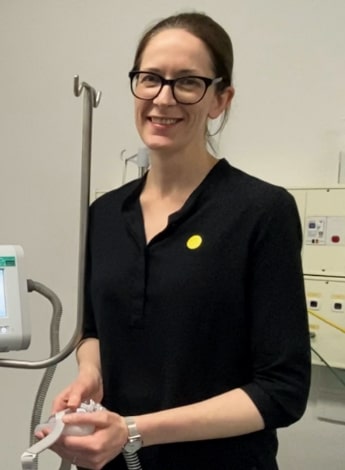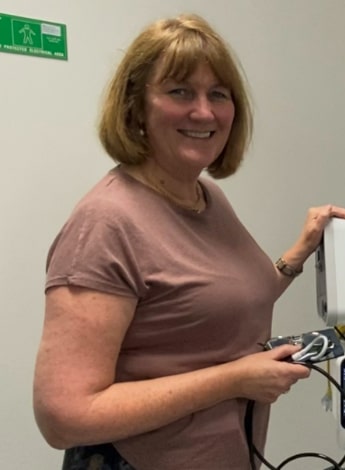
Wake up to sleep health

If physiotherapists aren’t asking their patients questions about sleep health, they could miss underlying factors that can inhibit a person’s good health. On the eve of Sleep Awareness Week, 14–20 March, we speak with cardiorespiratory physiotherapists about why sleep matters.
The patient before you is a middle aged man who has put on a bit of weight recently. His partner has noticed that he has begun to snore and that during the night he occasionally stops breathing.
The patient says this doesn’t really bother him—he doesn’t have florid diabetes or hypertension— but he finds that on the weekends he needs to have a nap.
This patient could be at risk of an undiagnosed sleep disorder, says physiotherapist clinician and researcher Professor David Berlowitz.
Given the cohort of patients that physiotherapists consult across the board, it’s likely that many patients are older, larger and they’re likely to have developed a sleep disorder.
This is where the profession intersects with sleep health research and clinical care. And this is why asking the questions about sleep patterns and behaviour are critical in the history-taking and clinical assessment process, David says.
‘It’s not normal to become a bit more sleepy as you get older. It can be, but it isn’t always. And most of these changes in peoples’ ability to breathe and sleep at the same time are fairly insidious,’ David says.
‘People only notice that they are impaired after they get treated. Patients talk about “lifting of the veil from across their eyes” when they get the treatment they so desperately need.
‘Sleep apnoea is as common as hypertension. If physiotherapists are not asking their clients and patients about how they sleep, they should be,’ David says.
Having worked at the Victorian Respiratory Support Service for the past 26 years and holding the University of Melbourne Chair in Physiotherapy at Austin Health, David leads an international team of research collaborators, students and staff who examine the causes and treatments of sleep and breathing disorders in neuromuscular disease.
Of particular focus is spinal cord injury and motor neurone disease (MND) as well as chronic disease management.
The Victorian Respiratory Support Service regularly treats people who can’t breathe enough on their own.
This includes individuals with stiff chests, obesity hyperventilation (where the load of breathing and the patient’s drive to breath is insufficient when they go to sleep), and progressive neuromuscular diseases like Duchenne’s muscular dystrophy or MND.
These particular disorders may not be conditions that are treated by every cardiorespiratory physiotherapist, but they are significant.
Given that everyone spends about a third of their life sleeping, it is curious that sleep health isn’t more of a research priority, David says.
While this often-overlooked sphere of human science is becoming better understood, it’s implications for long-term health and wellbeing are of vast importance to those who look after the health of others—and physiotherapists are at the frontline of that care.
‘Sleep has been affected in the time of COVID-19—everybody’s circadian rhythms have gone off, many of us are drinking more, which is good for getting you to sleep but really bad for the quality of your sleep once you’re there.
'Many people have also put on weight, which of course contributes to this as well,’ David says.
‘So there are lots of things which lead us to believe that the burden of sleep disorders has probably risen over the last 12 months. We don’t actually know for sure; however, there is some preliminary data suggesting that this is true.
‘We know that there’s a bidirectional relationship between pain and sleep—more pain makes sleep worse, and poor sleep makes pain worse.
'It’s a really important thing to consider in the holistic care of the person in front of you,’ David says.

‘So if physios aren’t asking their clients or patients about their sleep then it’s a concern that they’re potentially missing. It’s like asking a person with a sore back whether they sit at a desk all day—it’s part of the care of the whole person.
'It’s really hard to believe that something we do for a third of our life doesn’t matter.’
Breathing-related sleep disorders
For people who can’t breathe enough when they sleep, the physiotherapist’s role is typically around the initiation of nocturnal ventilatory support.
This might start in an acute hospital either with the patient being admitted electively (for instance, someone with a known neuromuscular disease) or it might be after an acute exacerbation where somebody has gone into respiratory failure and ended up in ED or intensive care with the need to be weaned from invasive ventilation, in some cases, and put onto non-invasive ventilation.
That process generally involves working out what is going wrong. This can sometimes involve an overnight sleep study.
While physiotherapists play an important role in setting these studies up, it is very much a team approach, which will include respiratory and sleep doctors, a ward nursing team and respiratory scientists.
At the Department of Respiratory and Sleep Medicine at Royal Prince Alfred Hospital (RPA) in Sydney, senior physiotherapist Dr Collette Menadue and her team manager, physiotherapist and well-known international authority on respiratory failure and non-invasive ventilation (NIV), Dr Amanda Piper, primarily manage the assessment and treatment of patients with acute and chronic hypercapnic respiratory failure due to a wide range of medical conditions.
The small team of cardiorespiratory physiotherapists regularly use NIV to treat their patients, and the team is also involved in sleep studies, clinics, community visits, telehealth, NIV during exercise rehabilitation and airway clearance, remote monitoring of ventilation and performing and interpreting pulmonary function tests.
‘Individuals with chronic hypercapnic respiratory failure generally use NIV to support breathing during sleep.
'We have a home ventilation program for people across NSW (usually have 300-plus patients at a time) and we also see acutely unwell patients within RPAH who require NIV support,’ Collette says.
‘Even though we predominantly deal with patients who have either acute or chronic hypercapnic respiratory failure, and we often treat them with non-invasive ventilation, while it may sound like we’re doing the same thing all the time, the patient groups that we see are quite varied.
‘We see people with neuromuscular disease, obesity hypoventilation syndrome or obesity- related respiratory failure, different types of lung disease, chest wall deformity and control of breathing disorders.
'Consequently the pathophysiology is quite varied and interesting. Often people can be quite complex and have a number of things going on at once, so it is challenging.’
Collette, who undertook her PhD research into the use of NIV during exercise in patients with respiratory failure, says she was inspired to undertake the research after working with a patient who was very ill with cystic fibrosis.
The patient was waiting for a lung transplant and was on continuous NIV.

A junior physiotherapist at the time, Collette says the experience showed her that her physiotherapy training and the skills it afforded to be able to triage, assess and diagnose patients were invaluable tools to work in an area for which she had developed a deep passion.
‘To keep this patient on the transplant list we had to use NIV during airway clearance, and we had to use NIV during exercise to try and maintain some sort of exercise tolerance so that he could tolerate getting through a lung transplant. For me, it was “Oh wow, this is pretty amazing stuff that we can do”.’
Collette and the team also work very closely with sleep and respiratory physicians and she says physiotherapists are valued members of the larger team working with sleep- related breathing disorders.
She says from a physiotherapy perspective, much of what she learned working in sleep was on-the-job because sleep was not a subject broadly covered during her own physiotherapy training.
‘At least physiotherapy students now have a little bit more contact with sleep and respiratory failure, and non-invasive ventilation, compared to when I went through.
'However, there’s still a lot of learning that has to happen on the job, such as learning how to interpret polysomnography, which is something that can take quite a long time,’ Collette says.
COVID-19 response and beyond
Like many other physiotherapists across the breadth of the profession, Collette and the team at RPA had to quickly adapt to the challenges thrown up by the COVID-19 pandemic, in particular the swift transition to telehealth and having to become more creative in ways to continue care of some remote patients.
Although the team had already been doing some remote monitoring of patients on home nocturnal ventilators before the pandemic hit last year, that has been accelerated during the pandemic and since.
Both Collette and Amanda cite one example of a patient with MND who was referred to the MND clinic at the Brain and Mind Centre at Sydney University during lockdown in Sydney.
The team at RPA is involved with that clinic (it is part of the RPA campus) and they had to help the patient who lives more than 500 kilometres from Sydney.
The patient required nocturnal ventilatory support but was unable to travel to Sydney to commence therapy.
After identifiying that the patient’s husband was already on a continuous positive airway pressure (CPAP) machine, the team couriered a bi-level machine and a whole range of masks to the patient’s home.
Using Zoom, Amanda, who led the project, talked the couple through mask fitting, and with remote monitoring technology, the team was able to review how the patient was responding and change settings on the machine remotely to establish her successfully onto bi-level therapy.
‘With our experience, we knew the rough settings to begin with, and we boxed up a device with a range of masks and sent it up to them. Her husband knew how to put a mask on and the basics of how to work the device,’ Amanda says.
‘By remote monitoring we were able to adjust the settings (some of the machines have certain automated aspects of them), and monitor her response to therapy.
'She was a big success even though we had not laid hands on her, and that came down to the remote monitoring capabilities we now have, and the fact her husband already knew how to use the equipment.’
Amanda says at the beginning of the pandemic, her team had to plan for the intensive care of COVID-19 patients who were to be accommodated in a specially created, dedicated ward at the busy metropolitan hospital in the heart of Sydney.
Had the hospital’s intensive care unit been filled up with COVID-19 patients, the team was to have been called on to provide CPAP or non- invasive ventilation to people with COVID-19 who are really unwell and very hypoxic in the ward setting.
‘We had to order in a lot of equipment, try and source various consumables, and develop therapy protocols—all that kind of thing,’ Amanda says.

‘We were able to acquire some equipment and we were working out plans on how to upskill other staff because, if there was a high workload, we’re quite a small team and would need other staff such as registrars and nursing staff to assist in the respiratory care of these patients.
'Thankfully it didn’t come to that in New South Wales, we were very fortunate that it didn’t happen.
‘But one of the issues with treatments like CPAP and NIV is that because of the high air flow rates they generate, virus particles can be aerosolised, spreading the disease to other patients and staff.’
Amanda says in the first few months of this year the sleep lab reopened and many of the outpatient clinics are now back up and running; however, they are doing so at a reduced rate.
With fewer patients being seen in the sleep lab, more home monitoring is occurring in the community.
Why sleep matters
All physiotherapists should understand that sleep takes up a large proportion of the 24- hour period, so an interest and appreciation of the impacts that sleep can have on both health and performance is not just limited to cardiorespiratory physiotherapists, Amanda says.
‘Whether you’re working in women’s and babies’ health, sports or in neurology rehab, sleep disordered breathing can have a huge impact on cognitive function, physical performance, resulting in a deterioration in people’s health and quality of life, if that sleep disordered breathing isn’t picked up and treated appropriately,’ Amanda says. ‘
And sleep breathing disorders aren’t just limited to the overweight, over 50-year-old male.
It can happen in children who have morphological changes to their upper airway because of craniofacial abnormalities.
It can occur in neuromuscular patients at any age with diaphragmatic weakness, stroke or in the postoperative patient following anaesthesia and opioids.
‘Sleep disordered breathing not only stretches across respiratory conditions, it also has an impact on cardiovascular health. Obesity, inflammation and sleep disordered breathing are all closely interconnected and prominent in people with cardiovascular and metabolic disorders.
‘The use of some CPAP and NIV devices in rehab, whether it’s cardiac rehab or respiratory rehab, can be incredibly important. Understanding those patients who will benefit from this intervention is crucial.
‘In people with neuromuscular disorders, not only do they need nocturnal ventilation but often their demise is caused by retained secretions, so having the skills to be able to manage both the inspiratory and expiratory muscle dysfunction becomes incredibly important.
‘Not all physios are involved in non-invasive ventilation; however, more and more physios (in the home, the community as well hospital settings) will be treating patients who use these machines.
'So understanding what that means and how this differs from treating someone who, for example, uses a CPAP machine is important for all physiotherapists to know.’
The role of physiotherapy in sleep disorders
Mary O’Keeffe explores some of the sleep disorders that clinicians are likely to encounter in their patient population, and some of the key research findings into their treatment. Mary’s current research focuses on improving media coverage and public understanding of low back pain.
Obstructive sleep apnoea
Obstructive sleep apnoea (OSA) is a prevalent sleep-related breathing disorder characterised by recurrent episodes of partial or complete collapse of the upper airway during sleep, resulting in reduced or absent airflowing for at least 10 seconds and associated with a cortical arousal or a fall in blood oxygen concentration.
It is a major cause of excessive sleepiness, contributing to reduced quality of life, impaired work performance, and increased motor vehicle crash risk.
Non-drug treatments include abstinence from alcohol, avoiding supine (lying on your back) sleep position, regular aerobic exercise and weight loss.
In patients with positional OSA (ie, more problems predominantly in the supine position), restricting sleep to side or prone position may be sufficient treatment.
Weight loss improves OSA and should be recommended for all patients who are overweight or obese. There is no apparent threshold amount of weight loss needed to improve OSA severity; greater weight loss is associated with greater benefit.
Aerobic exercise may improve OSA independently of weight loss.

There is a dose-dependent association of exercise with lower prevalence of OSA—for example, people who exercise seven hours a week have lower apnoea severity compared to people who exercise one to two hours or three to six hours. Why exercise helps is unclear.
Fat redistribution, reduced night-time fluid resorption from the legs, increased pharyngeal muscle strength, and improved sleep quality are potential mechanisms.
Positive airway pressure is the primary therapy for individuals with symptomatic OSA of any severity.
Positive airway pressure devices deliver pressure to the airway through a mask worn over the nose or the nose and mouth.
This pressure acts as a splint to prevent airway collapse during inspiration.
Benefit depends on adherence to therapy, with more hours of use per night associated with greater symptom improvement and greater blood pressure reduction.
Although arbitrary, good adherence is commonly defined as use for at least four hours per night for at least five nights per week.
Oral appliances (mandibular repositioning devices) are effective treatment options, particularly for individuals with mild to moderate OSA. These devices consist of plates made to fit the upper and lower teeth.
The positions of these plates can be adjusted, allowing advancement of the mandible relative to the maxilla, resulting in increased upper airway volume and, consequently, reduced airway collapsibility.
Inspiratory muscle training can be helpful for reducing apnoea and breathlessness in patients with OSA.
In one randomised study, the training comprised of 30 breaths each day for six weeks using an inspiratory threshold training device, with the inspiratory muscle training group trained against a resistance set to 75 per cent of their maximum inspiratory pressure.
Participants receiving this training experienced better improvements over the control group, which received inspiratory muscle training set to 15 per cent of their maximum inspiratory pressure (Gottlieb & Punjabi 2020).
Sleep quality in fibromyalgia
More than 80 per cent of people with fibromyalgia experience severe fatigue or poor sleep quality, both of which are identified by people with fibromyalgia and healthcare providers as priority targets for treatment.
From a physiotherapy perspective, there is low to moderate evidence that exercise training, particularly mediative exercise (eg, tai chi, yoga) can improve sleep quality in people with fibromyalgia.
Strength and flexibility training have similar effects. Water and land-based exercise have effects on sleep and fatigue, with no one exercise being superior to another.
There is a lack of research available on what is the optimal dose of exercise, and it is recommended that clinicians consider patient preferences and increase exercise in a graded manner.
Sleep quality in axial spondyloarthritis
Axial spondyloarthritis (axSpA) is a chronic inflammatory rheumatic disease primarily affecting the axial skeleton.
The disease includes both patients with radiographic structural damage of the axial skeleton (ankylosing spondylitis), and patients without structural damage (non-radiographic axSpA).
Patients report that besides pain, fatigue and sleep are their most important health aspects.
Fatigue is explained by an interaction between different factors such as inflammation, medication, pain, sleep, and deconditioning.
One randomised clinical study (Sveaas et al 2020) found that high-intensity exercise can improve sleep quality and reduce fatigue in this population when compared to education alone.
The exercise in this trial consisted of 40 minutes of cardiorespiratory exercise and 20 minutes of strength exercises.
The cardiorespiratory exercise was performed on a treadmill or a cycle ergometer at high intensity (10 minutes of warm-up, thereafter four minutes of forceful walking/running or bicycling at 90–95 per cent of maximal heart rate, followed by three minutes of active resting at 70 per cent of maximal heart rate repeated four times).
The strength exercises were individually adapted to each participant and focused on major muscle groups (squats, leg press, deadlifts, rows to chest, bench press, shoulder press, pulldowns, and sit-ups) and included eight to 10 repetitions maximum in two to three sets.
In addition to the supervised sessions, patients in the exercise group were encouraged to perform a cardiorespiratory exercise session once a week on their own for at least 40 minutes at an intensity level above 70 per cent of maximal heart rate (controlled by pulse-watch).
Low back pain and osteoarthritis
Insomnia symptoms are highly prevalent in individuals presenting with musculoskeletal pain, with 71 per cent of people with osteoarthritis, 59 per cent with low back pain, and 41 per cent with neck pain either diagnosed with insomnia or reporting significant insomnia symptoms.
These symptoms include poor sleep quality, non-restorative sleep, early awakenings and difficulty initiating and maintaining sleep.
Insomnia disorder is no longer viewed as a consequence of pain or depression but as a parallel condition which requires specific management.
There is low to moderate evidence that non- drug treatments including aerobic exercise and cognitive behavioural therapy can improve sleep quality in patients with back pain and osteoarthritis, compared to sleep hygiene advice alone or treatments that do not include a sleep education component (Ho et al 2019).
Insomnia in middle aged to older adults
Insomnia is defined by a persistent inability to fall asleep or maintain sleep.
The prevalence of insomnia in adults has been reported to range from 10–40 per cent across various countries. There is some data showing that insomnia increases with age (Yang et al 2012).
It has a substantial negative impact on mental and physical health, quality of life, and increases healthcare costs.
Lack of sleep can lead to increased fatigue and excessive daytime sleepiness. It can also impair the metabolic, endocrine, and immune systems.
The overall research shows that participation in a cognitive behavioural therapy program could reduce sleep latency and time spent awake after sleep onset by approximately 30 minutes, increase total sleep time by approximately 30–45 minutes, and increase sleep efficiency up to approximately 70–85 per cent.
Exercise programs are also recommended to help prevent and treat sleep disorders as well as the associated depression.
Most trials have examined aerobic exercise (endurance training, walking, or tai chi) with fewer trials examining a resistance/strengthening exercise program. The treatment length in most trials is between 10 and 16 weeks.
The exercise is generally compared to no treatment or health education.
All aerobic exercise programs examined are of moderate intensity, instructing the participants to reach 60–70 per cent of their heart rate reserve or 60–85 per cent of their peak heart rate for 40–60 minutes.
The evidence shows that overall, exercise training has a moderate beneficial effect on sleep quality and sleep medication usage. However, exercise does not change sleep duration, efficiency, and disturbance.
Therefore, patients do not sleep for a longer duration after participation in exercise training but they experienced improved sleep quality.
Email inmotion@australian.physio for references.
>> Mary O’Keeffe is a physiotherapist and Marie Skłodowska-Curie Postdoctoral Research Fellow at the Institute for Musculoskeletal Health in Sydney. Mary completed her PhD in 2017 in Ireland in the area of individualised multidimensional care for chronic low back pain. Mary is interested in media coverage and public perceptions of low back pain. She has published 80 papers relating to low back pain, other musculoskeletal pain conditions and media coverage of tests and treatments.
© Copyright 2025 by Australian Physiotherapy Association. All rights reserved.





